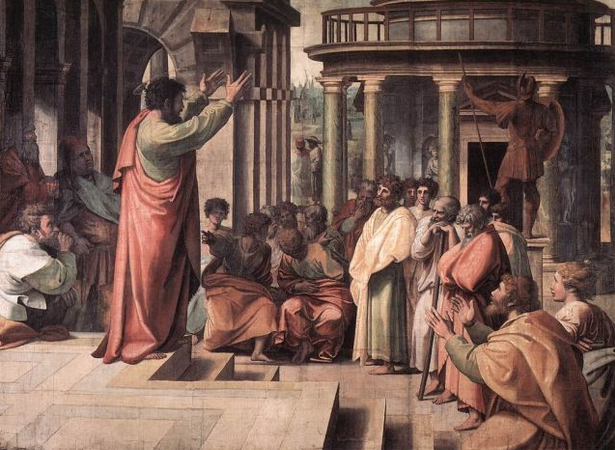Lessons from the Nursery
The Catholic Imagination Encounters Bambi
In my family, it is our habit to read to the children before we put them to bed. Usually, it’s a few picture books without much substance, which move along fairly quickly—though the Pokey Little Puppy never seems to move quite fast enough for me. I must say, however, that I do enjoy the earlier Dr. Seuss material—especially the moralistic stuff—Horton Hatches the Egg (“I meant what I said and I said what I meant, an elephant’s faithful 100 percent”) and Horton Hears a Who (“A person’s a person. No matter how small”—a small didactic point for our generation).
We also have been reading our children some more substantial works—short novels like George MacDonald’s The Light Princess, a most happy allegory; and a children’s version of Pilgrim’s Progress. But a truly wonderful and unexpected pleasure, one could almost say an aesthetic experience, came to me recently through my parental reading of Felix Salten’s Bambi.
Now like most of you, the title Bambi immediately conjures up visual associations of the full-length Disney cartoon by that name. There is a certain romance to that version of the tale—but it is a Disney romance. We are subject to the childish delight in the wide-eyed Bambi, the frolicsome rabbit Thumper, and the shy little skunk, appropriately named Flower. These two last characters don’t even appear in the Salten text. In fact, there is so much alteration in tone and content that one ought to view the novel and the cartoon as two separate works, rather like two different versions of a myth.
Salten writes in the tradition of Aesop, but it is Aesop with a Wagnerian soundtrack. His word pictures of animals distill the spiritual substance of life. The reviewer in the Catholic World of 1928 said that Salten’s “approach to his subject is marked by poetry and sympathy and there are charming reminders of German folklore and fairy tale in his nature world.”1 E. H. Walton in the Bookman held that “the story is told with an enchanting clarity and simplicity. It creates its own atmosphere and its own terms.”2 Salten has given us a prose poem.
Hidden in our humanity, like some vestige of Adamic headship, is our unity with the animal world; there we find the imaginative ability to see through beastie eyes. It is not only pleasing, it also is almost necessary. Seeing with the animals reminds us of our creaturehood. Salten understands this preternatural link. This same perceptual power is seen in the modern fiction of Richard Adams’s Watership Down and Walter Wangerin, Jr.’s Book of the Dun Cow.
The lyrical power of Bambi in English came through the translating pen of Whittaker Chambers. A Communist at the point of translation, Chambers “thought the story rather sentimental, but it brought back to me my boyhood days in the woods, when I was watching the flight and pursuit of creatures under the ponds or among the grass stems. I made the translation. Bambi was an instant success. . . .”3 Even a dialectical materialist recognizes the romance.
Visions of Eros & Freedom
As I read Bambi, a number of emotion-charged visions made me pause. I literally stopped reading and set the book down more than once, overcome with a kind of aesthetic shock that takes the wind out of you.
The first experience occurred in the chapter on leaves. Hardly what one would consider the most promising topic for high art. Nevertheless, the chapter on leaves forms a picturesque parable of the problem of our existence. Two leaves discuss mutability and the afterlife:
They were silent a while. Then the first leaf said quietly to herself, “Why must we fall? . . .” The second leaf asked, “What happens to us when we have fallen?” “We sink down.” “What is under us?” The first leaf answered, “I don’t know, some say one thing, some another, but nobody knows.” The second leaf asked, “Do we feel anything, do we know anything about ourselves when we’re down there?” The first leaf answered, “Who knows? Not one of all those down there has ever come back to tell us about it.”4
Not one? Well, Salten is defining the human predicament, not presenting the gospel. And as a definition of the human situation, it is marvelous. The parable goes on and achieves that brave agnosticism that is found in parts of the Old Testament Wisdom literature. There is a sad, solitary pain as the leaves fall one by one. And so we will wither; all flesh is grass. Vanity of vanities, saith the Preacher.
The second vision revolves around, of all things, the power of Eros. Faline is Bambi’s mate. Bambi awakes from sleep and finds that his Faline is not to be found. Frantic, he hears Faline’s voice in the distance and begins to rush toward it, only to have his path blocked by the Great Stag. He must get to her. He must. The Stag tells him that it is not Faline. Bambi argues with the Stag. Can it be true? But Faline calls him. She calls. Finally, the Great Stag shows him that it is not Faline, but a man making her voice—a deceptive imitation from Bambi’s natural enemy. The Stag’s wisdom has preserved Bambi from death. Later he finds his lovely Faline safe and sound:
He was breathless, tired and happy and deeply stirred. “Please, beloved,” he said, “please don’t ever call me again. We’ll search until we find each other, but please don’t ever call me . . . for I can’t resist your voice.”5
I don’t think there can be a more evocative expression of Eros. This is not lust, but pure holy desire: “please don’t ever call me . . . for I can’t resist your voice.” I am undone. My children yawn. They turn over and go to sleep as I read. I lay down the book, while my imagination flies to her form with whom I share my bed and life. I hear her move to the stairs. She is a poem. Her voice calls me from a distance. “Are the children asleep?” She calls. O Lord, I cannot resist her voice.
The third vision occurs with the return of Gobo and reflects the problem of freedom and slavery in a bare, unadorned way. With one little word picture, Salten devastates our self-delusion of freedom in a world that offers no guarantee from risk. Gobo, a fawn who had been presumed dead, returns after having been captured by men and tamed. The Old Stag is again the voice of Wisdom in this age of moronic youth:
“What kind of band is that you have on your neck?” Everybody looked at it and noticed for the first time the dark strip of braided horsehair around Gobo’s neck. Gobo answered uneasily, “That? Why that’s part of the halter I wore. It’s His halter and it’s the greatest honor to wear His halter, it’s . . .” He grew confused and stammered. Everyone was silent. The old stag looked at Gobo for a long time, piercingly and sadly. “You poor thing!” he said softly at last, and turned and was gone.6
The Old Stag is not angry; he does not lecture; he merely gazes, understands, and pronounces judgment. Gobo is a deluded fool: a once free deer whose heritage was to range the forest, now an apologist for tyranny. He rejoices in his slavery. He wears his chain as a mark of honor. He has achieved Orwellian doublethink: “Freedom is Slavery.” Gobo is the embodiment of all modern men who have given up the wild liberty of their forefathers for the security of a little food, a little credit, a little health insurance, a little pension. Gobo is Esau selling his birthright.
The fourth aesthetic experience occurs in the fox hunt scene—the problem of treachery forms the basis for a heroic last stand. Chased by the barking dogs, the cornered fox pleads for his life:
“ . . . [L]et me go.” He spoke softly and beseechingly. He was quite weak and despondent. “No! No! No!” the dog howled. The fox pleaded still the more insistently. “We’re relations,” he pleaded, “we’re brothers almost. Let me go home. Let me die with my family at least. We’re brothers almost, you and I.” “No! No! No!” the dog raged. Then the fox rose so that he was sitting perfectly erect. He dropped his handsome pointed muzzle on his bleeding breast, raised his eyes and looked the dog straight in the face. In a completely altered voice, restrained and embittered, he growled, “Aren’t you ashamed, you traitor!” “No! No! No!” yelped the dog. But the fox went on, “You turncoat, you renegade.” His maimed body was taut with contempt and hatred. “You spy,” he hissed, “you blackguard, you track us where He could never find us. You betray us, your own relations, me who am almost your brother. And you stand there and aren’t ashamed!”7
In the face of tyranny there are only two responses: acquiescence or sacrificial fortitude. Life is a choice between a Vichy existence or a Warsaw ghetto uprising. Salten teaches us that it is better to die with the honor of self-respect and truth than to live as a treacherous dog.
Mortality & Life
And finally, there is the scene in which Bambi confronts a Dead Man—and all of his notions of mankind’s divinity are toppled. In one great iconoclastic blast, Salten has the Great Stag say of man:
“Listen, Bambi. He isn’t all powerful as they say. Everything that lives and grows doesn’t come from Him. He isn’t above us. He’s just the same as we are. He has the same fears, same needs, and suffers the same way. He can be killed like us, and then He lies helpless on the ground like all the rest of us. . . .”8
The toppling of man from the Temple of Animal-land parallels for the Romantic mind all rebellion against divinity. But it is important to notice that it is false divinity that Salten has removed from the center of worship. In spite of this orthodox truth, we must recognize that Salten has given us a sub-Christian, and indeed a sub-Hebraic view of man: placing man and animal on a common plane below their Creator. Man certainly is an animal, but he is the divine animal—the Imago Dei. Salten asserts an egalitarianism of all species that is at odds with the Judeo-Christian hierarchical model recounted in Lovejoy’s Great Chain of Being and established in the biblical literature.
Salten’s haunting treatment of the woodland ought not to blind us to the errors of his theology. Not everything that Mr. Salten has said is true. Indeed, he is the perfect example of the dictum that “the poet tells lies.” But they are pleasing lies, the fictions that bear fragments of truth.
The smell of Judeo-Christian sentiment mingles with the green-gray Northland forests. Yet it is ironic that Felix Salten, pseudonym for the Jewish journalist Siegmund Salzmann, and a refugee from Nazi Austria, should write a text that celebrates, however so slightly, the notion of the Overman—the individual, the Steppenwolf. This German Romanticism runs through Salten’s work. Nature is celebrated; wildness is placed above domesticity. The lone silent Stag is given the place of heroic center.
Salten has made me think and feel life’s struggle; he has moved my heart through forest parable. I have learned to see through a children’s book the problem of life and the hereafter; the power of Eros; the dignity of liberty and the sadness of servility; the nobility of death nobly faced and the curse of existence treacherously lived. And I have learned to see Man, that god of animals, stretched and bleeding on the ground—impotent, mortal, most unworthy of worship. Like Bambi, I am forced to confess when I survey the frailty that is Man that “there is Another who is over us all, over us and over Him.”9
These are good lessons to learn, especially in the nursery of life.
Notes:
1. M. C. M., Catholic World, vol. 128 (December 1928), p. 376.
2. Walton, E. H., Bookman. vol. 68 (September 1928), p. 99.
3. Whittaker Chambers, Witness (New York: Random House, 1952), p.
239.
4. Felix Salten, Bambi (New York: Simon & Schuster, 1929), pp.
106–109.
5. Ibid., p. 192.
6. Ibid., p. 210.
7. Ibid., p. 274.
8. Ibid., p. 286.
9. Ibid., p. 286.
James L. Sauer is the Director of Warner Memorial Library at Eastern College in St. Davids, Pennsylvania. He and his wife, Paula, live in Coatesville, Pennsylvania with their seven children.
subscription options
Order
Print/Online Subscription

Get six issues (one year) of Touchstone PLUS full online access including pdf downloads for only $39.95. That's only $3.34 per month!
Order
Online Only
Subscription

Get a one-year full-access subscription to the Touchstone online archives for only $19.95. That's only $1.66 per month!
bulk subscriptions
Order Touchstone subscriptions in bulk and save $10 per sub! Each subscription includes 6 issues of Touchstone plus full online access to touchstonemag.com—including archives, videos, and pdf downloads of recent issues for only $29.95 each! Great for churches or study groups.
Transactions will be processed on a secure server.
more on imagination from the online archives

11.5—September/October 1998
Speaking the Truths Only the Imagination May Grasp
An Essay on Myth & 'Real Life' by Stratford Caldecott
more from the online archives
calling all readers
Please Donate
"There are magazines worth reading but few worth saving . . . Touchstone is just such a magazine."
—Alice von Hildebrand
"Here we do not concede one square millimeter of territory to falsehood, folly, contemporary sentimentality, or fashion. We speak the truth, and let God be our judge. . . . Touchstone is the one committedly Christian conservative journal."
—Anthony Esolen, Touchstone senior editor












